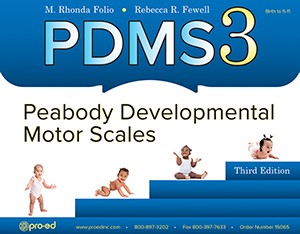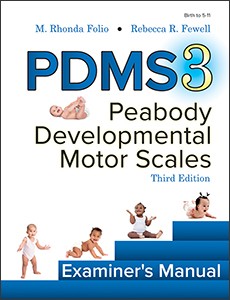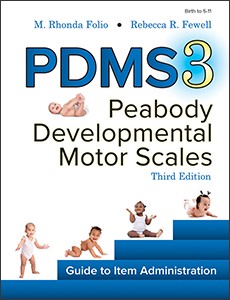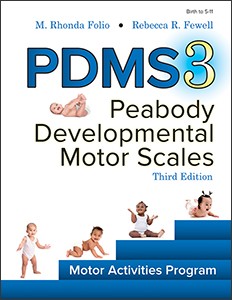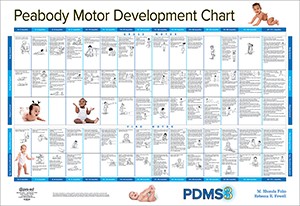The Peabody Developmental Motor Scales–Third Edition (PDMS-3) is an early childhood motor development program that provides both in-depth assessment and training or remediation of gross and fine motor skills. The assessment measures interrelated motor abilities that develop early in life. The PDMS-3 can be used by occupational therapists, physical therapists, diagnosticians, early intervention specialists, adapted physical education teachers, psychologists, and others who are interested in examining the motor abilities of young children.
The PDMS-3 has five core subtests and one supplemental subtest:
CORE SUBTESTS
- Body Control—This subtest measures the ability to move the limbs and trunk, postural reactions, standing, bending, extending, stooping, balancing, jumping upward. It is an estimate of the child's ability to sustain control of his or her body within its center of gravity and retain equilibrium.
- Body Transport—This subtest measures the ability to make movements that propel the child from one location to another, such as rolling, crawling, creeping, walking, running, jumping forward and sideward, sliding, hopping, and skipping.
- Object Control—This subtest measures the ability to coordinate motor movements that require the incorporation of perception and movement, such as throwing, catching, bouncing, and kicking a ball.
- Hand Manipulation—This subtest measures the ability to move the hands and fingers (and arms as appropriate) to complete tasks and measure dexterity. This includes manipulation of objects such as blocks, cups, and drawing instruments.
- Eye-Hand Coordination—This subtest measures the ability to interpret visual stimuli in coordination with hand-finger movements. It is an estimate of the child's ability to integrate and use his or her visual perceptual skills to perform complex eye-hand coordination tasks.
SUPPLEMENTAL SUBTEST
- Physical Fitness—This supplemental subtest measures the ability to perform activities like push-ups, sit ups, repetitive jumps, running speed, throwing for distance, and sit and reach/flexibility.
COMPOSITES
The PDMS-3 has three composites. These composites are derived from combining the results of the subtests to achieve stronger and better indices of performance. The scores of these composites are more reliable and valid than the subtests.
- Gross Motor Index—This composite is a combination of the results of the Body Control, Body Transport, and Object Control (children 16 months and older) subtests, which measure the use of the large muscle systems. This index score represents the child's ability to use the large muscle systems to react to environmental changes, assume a stable posture when not moving, move from place to place, and catch, throw, and kick balls.
- Fine Motor Index—This composite is a combination of the results of the Hand Manipulation and Eye-Hand Coordination subtests, which measure the use of the small muscle systems. This index score represents the child's ability to use his or her fingers, hands, and to some extent arms to grasp objects, stack blocks, draw figures, and manipulate objects.
- Total Motor Index—This composite is formed by a combination of the results of the gross and fine motor core subtests. Because of this, it is the best estimate of overall motor abilities.
NORMATIVE SCORES
Access to the new PDMS-3 Online Scoring and Report System is now included with the purchase of each PDMS-3 Complete Kit and with the purchase of every replacement pack of Examiner Record Booklets and Supplemental Subtest Booklets. This scoring and report system is a quick, efficient tool for (a) generating materials (blackline masters, lined paper) needed for administration; (b) entering test session data; (c) converting subtest item scores or total raw scores into scaled scores; (d) generating composite index scores, percentile ranks, and upper and lower confidence intervals; (e) comparing PDMS-3 performances to identify significant intra-individual differences; (f) obtaining a score summary or narrative report; and (g) generating treatment goals and objectives based on the item performance of the child.
The PDMS-3 Online Scoring and Report System yields four types of normative scores: age equivalents, percentile ranks, subtest scaled scores, and composite index scores. Age equivalents are indexes of relative standing that translate subtest raw scores into motor ages. Percentiles provide the examiner with an index that is easily understood by parents and other with whom the test results are to be shared. Subtest scaled scores are based on a distribution having a mean of 10 and a standard deviation of 3. Composite indexes are based on a distribution having a mean of 100 and a standard deviation of 15.
FEATURES
- The subtests of the PDMS–3 were renamed to reflect a better understanding of the skills required by the items. The three gross motor subtests are now titled Body Control, Body Transport, and Object Control. The two fine motor subtests are now Hand Manipulation and Eye-Hand Coordination.
- A supplemental subtest, Physical Fitness, was added to reflect the current literature’s interest in overweight, obesity, and fitness testing of preschool children.
- The Examiner Record Booklets now contain complete administration and scoring instructions, allowing administration of the test without using the Examiner’s Manual.
- A PDMS-3 Scoring Transparency containing images of a protractor and ruler to aid examiners in scoring of certain items is included in the kit.
- The Illustrated Guide to Item Administration was revised, and many illustrations have been replaced or updated. The items are referenced by number within each subtest and each item description includes: (a) the age at which 75% of the children in the normative sample mastered the item, (b) the position the child should be in when the item is administered, (c) the materials (if needed) for presenting the item, (d) the procedure used to test the item, (e) the criterion used to score the item, and (f) the illustration of a child performing the item.
- The Motor Activities Program was revised to be more user friendly. The MAP is the instruction/treatment program for the PDMS-3. It contains units organized developmentally by skill area. After a child's motor skills have been assessed and the examiner has completed all sections of the Profile/ Summary Form, the examiner selects units from the MAP to use to facilitate the child's development in specific skill areas.
- The manipulative kit has been expanded to include most of the manipulatives needed for testing to better ensure the standardized administration of items.
- The Peabody Motor Development Chart has been updated. It provides the examiner with a convenient reference for the motor skills measured by the PDMS-3 and the ages at which 75% of the normative sample performed the skill. Each of the subtests is represented along with numerous illustrations of children demonstrating the behaviors described in the text.
- The PDMS-3 norms are based on an all-new sample of 1,452 children who were tested from Spring of 2016 through Spring of 2021.
- The demographic characteristics of the sample were stratified by age to conform to those of the projected U.S. under 5 years of age population for the year 2021 as reported in the ProQuest Statistical Abstract of the United States 2021 (ProQuest, 2021) and are thereby representative of the U.S. population. The demographic characteristics of the sample were also stratified by age for geographic region, race, ethnicity, gender, parent education, and household income.
- New and extensive studies of test bias (both differential item functioning and subgroup comparison studies) were conducted, indicating the PDMS-3 possesses little or no bias regarding gender, race, or ethnicity.
- New and extensive criterion-prediction validity studies were conducted to demonstrate the validity of the PDMS-3’s subtests and composites, including diagnostic accuracy and receiver operating characteristic/area under the curve (ROC/AUC) analyses. Diagnostic accuracy analyses are particularly rigorous techniques for establishing validity involving the computation of a test's sensitivity index, specificity index, and ROC/AUC. These studies indicate that the PDMS-3 is a highly valid measure of motor skills.
- New studies of construct-identification validity, including studies of age differences, subgroup performance, relationship to language, relationship to social-emotional development, and relationship to adaptive behavior were conducted. Factor analyses of the test’s structure by age were also performed. These studies indicated that the PDMS-3’s internal structure is sound, and its results are valid for a wide variety of subgroups, as well as for a general population.
- Access to the new PDMS-3 Online Scoring and Report System is now included and provides an efficient and easy way to obtain PDMS-3 scores and corresponding narrative.
 *Contains small parts that may be a choking hazard for children under the age of 3.
*Contains small parts that may be a choking hazard for children under the age of 3. 
 Proud to be Canadian
Proud to be Canadian